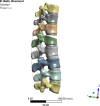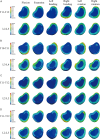Biomechanical Effect of Different Posterior Fixation Techniques on Stability and Adjacent Segment Degeneration in Treating Thoracolumbar Burst Fracture With Osteoporosis: A Finite Element Analysis
- PMID: 38721831
- PMCID: PMC11232937
- DOI: 10.1097/BRS.0000000000005034
Biomechanical Effect of Different Posterior Fixation Techniques on Stability and Adjacent Segment Degeneration in Treating Thoracolumbar Burst Fracture With Osteoporosis: A Finite Element Analysis
Abstract
Study design: Finite element analysis.
Objective: To investigate the biomechanical effect of four posterior fixation techniques on stability and adjacent segment degeneration in treating thoracolumbar burst fractures with osteoporosis.
Summary of background data: In terms of stability and adjacent segment degeneration, there remains no consensus or guidelines on the optimal technique for the treatment of thoracolumbar burst fractures in patients with osteoporosis.
Materials and methods: Images of CT scans were imported into MIMICS and further processed by Geomagic to build three-dimensional models of the T10-L5 region. A v-shaped osteotomy was performed on the L1 vertebral body to simulate a burst fracture in the setting of osteoporosis. Subsequently, four fixation techniques were designed using SolidWorks software. Range of motion (ROM) of the global spine, ROM distribution, ROM of adjacent segment, Von Mises stress on adjacent intervertebral disks, and facet joints were analyzed.
Results: Among the four groups, the cortical bone screw fixation (CBT) showed the highest global ROM at 1.86°, while long-segmented pedicle screw fixation (LSPS) had the lowest global ROM at 1.25°. The LSPS had the smallest percentage of ROM of fractured vertebral body to fixed segment at 75.04%, suggesting the highest stability after fixation. The maximum ROM of the adjacent segment was observed in the CBT at 1.32°, while the LSPS exhibited the smallest at 0.89°. However, the LSPS group experienced larger maximum stress on the adjacent intervertebral disks (9.60 MPa) and facet joints (3.36 MPa), indicating an increasing risk of adjacent segment disease.
Conclusion: LSPS provided the greatest stability, while CBT provided the smallest amount of stability. However, the elevated stress on adjacent intervertebral disks and facet joints after LSPS fixation increased the possibility of adjacent segment degeneration. Cement-augmented pedicle screw fixation (CAPS) and combined cortical bone screw and pedicle screw fixation (CBT-PS) demonstrated significant biomechanical advantages in providing moderate fixation strength while reducing stress on the intervertebral disks and facet joints.
Copyright © 2024 The Author(s). Published by Wolters Kluwer Health, Inc.
Conflict of interest statement
The authors report no conflicts of interest.
Figures









Similar articles
-
Biomechanical evaluation of different posterior fixation techniques for treating thoracolumbar burst fractures of osteoporosis old patients: a finite element analysis.Front Bioeng Biotechnol. 2023 Nov 1;11:1268557. doi: 10.3389/fbioe.2023.1268557. eCollection 2023. Front Bioeng Biotechnol. 2023. PMID: 38026889 Free PMC article.
-
Finite element analysis of short-segment fixation combined with expandable polyetheretherketone vertebral body replacement in osteoporotic vertebrae.BMC Musculoskelet Disord. 2025 Aug 20;26(1):806. doi: 10.1186/s12891-025-09065-1. BMC Musculoskelet Disord. 2025. PMID: 40830948
-
Treatment of thoracolumbar burst fractures by short-segment pedicle screw fixation using a combination of two additional pedicle screws and vertebroplasty at the level of the fracture: a finite element analysis.BMC Musculoskelet Disord. 2017 Jun 15;18(1):262. doi: 10.1186/s12891-017-1623-0. BMC Musculoskelet Disord. 2017. PMID: 28619021 Free PMC article.
-
Effective method of pedicle screw fixation in patients with neurologically intact thoracolumbar burst fractures: a systematic review of studies published over the last 20 years.Neurocirugia (Engl Ed). 2024 Nov-Dec;35(6):299-310. doi: 10.1016/j.neucie.2024.07.009. Epub 2024 Jul 31. Neurocirugia (Engl Ed). 2024. PMID: 39089628
-
Fractures of the thoracolumbar spine in osteoporosis.Eur J Trauma Emerg Surg. 2024 Oct;50(5):1977-1984. doi: 10.1007/s00068-024-02625-5. Epub 2024 Sep 10. Eur J Trauma Emerg Surg. 2024. PMID: 39254697 Free PMC article. Review.
Cited by
-
Analysis of Risk Factors for Augmented Vertebral Refracture After Percutaneous Kyphoplasty in Osteoporotic Vertebral Compression Fractures.J Clin Med. 2025 Jan 8;14(2):329. doi: 10.3390/jcm14020329. J Clin Med. 2025. PMID: 39860335 Free PMC article.
-
Integrating finite element analysis and physics-informed neural networks for biomechanical modeling of the human lumbar spine.N Am Spine Soc J. 2025 Feb 17;22:100598. doi: 10.1016/j.xnsj.2025.100598. eCollection 2025 Jun. N Am Spine Soc J. 2025. PMID: 40160481 Free PMC article.
-
Comparative assessment of surgical outcomes and cost-efficiency between orthopedic surgeons and neurosurgeons in degenerative lumbar spine surgery: a systematic review with pairwise and proportional meta-analysis.Neurosurg Rev. 2025 Mar 18;48(1):308. doi: 10.1007/s10143-025-03452-x. Neurosurg Rev. 2025. PMID: 40102318
References
-
- Xu J, Yin Z, Li Y, Xie Y, Hou J. Clinic choice of long or short segment pedicle screw-rod fixation in the treatment of thoracolumbar burst fracture: from scan data to numerical study. Int J Numer Method Biomed Eng. 2023;39:e3756. - PubMed
-
- Wood KB, Li W, Lebl DR, Ploumis A. Management of thoracolumbar spine fractures. Spine J. 2014;14:145–64. - PubMed
-
- Xu G, Fu X, Du C, et al. . Biomechanical comparison of mono-segment transpedicular fixation with short-segment fixation for treatment of thoracolumbar fractures: a finite element analysis. Proc Inst Mech Eng H. 2014;228:1005–13. - PubMed
MeSH terms
LinkOut - more resources
Full Text Sources
Medical
Research Materials
Miscellaneous

